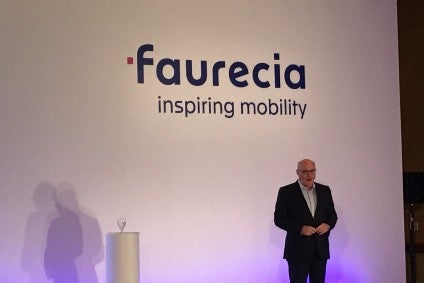
Faurecia says it believes electrification will approach 25% of the car parc in China as a rising global population coupled with increased longevity will drive alternative mobility solutions.
Speaking at the Consumer Electronics Show (CES) in Las Vegas, the French supplier outlined some of its philosophy to meet changing demographics aligned with a rising urbanisation eager to embrace mega-trends.

Discover B2B Marketing That Performs
Combine business intelligence and editorial excellence to reach engaged professionals across 36 leading media platforms.
“We believe Level 4 [automation] in 2030 [will be] between 10% and 30% – nobody knows what the real figure will be,” said Faurecia CEO, Patrick Koller in Las Vegas. Electrification may be 25% for the most optimistic forecasts, with big differences between the US and China where we will be close to 25%.
“You have millennials with a clear focus on mobility rather than ownership. In 1960, 80% of the population survived to 70 years old and in 2030, 80% should survive to 80. In 2030 we will be close to 60% of urban population. The leading growth region will stay Asia [while] 50% of all AI-related start-ups were financed by China and 44% of worldwide luxury consumption was [also] China.
“Our world is changing. We are going from a complicated world to a complex world. We have a clear vision, but it is very difficult to predict at what speed we can achieve it. We have the Cockpit of the Future with individual time management where the addressable market is estimated at EUR81bn (US$93bn).
“What is new for Faurecia for sure is we have to be very much focused [on the] life cycle of our products. In the Cockpit of the Future we have advanced safety, enhanced comfort and immersive sound experience, adaptive cabin and cloud-based services [as well as] personal climate control.
” We have to know what is the value chain and in what areas we might invest and other areas where we might partner. We need to work with experts in different fields: ZF for safety systems; Halle for interior lighting, Accenture for AI; Hitachi on autonomous driving. We are working with academics which allows you to accelerate and of course we are working with start-ups and partners who are more technology partners, for example Corning on glass. We are [also] working on activated surfaces so you do not use loudspeakers any more.
“We do not try to increase cost because we know in the context of electrification and autonomous driving, it is just not possible.
“We are trying to increase the content per vehicle by 50%: new market segments, new customers and towards a B2C business model. We have to combine consumer expectations with customer expectations, [while] we have to think about experiences and no more about functionality. We know what the mega-trends are, but at the same time this path is very uncertain and we need to go on with small steps.”
The Faurecia chief also touched on other potential trends such as the need for self-cleaning materials which might be needed if ride-sharing takes off significantly.
Equally, instead of purchasing a different car, consumers might opt to change the interior instead.






